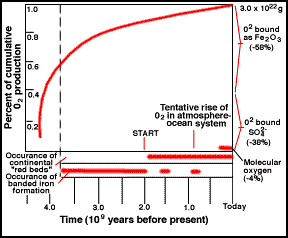
Objectives:
(1) Evolution of the atmosphere(2) Spontaneous versus non-spontaneous origin of life
(3) Importance of clays
The early atmosphere was oxygen poor. The first component gases were
H2O, CO2, CH4, NH3, H2.
Weathering of raocks began by
CO2 + H2O makes H2CO3 (carbonic acid)
which dissolves rocks (removes CO2).
The geological record of marine-deposited rock types helps prove this latter point.
One type of evidence comes from banded iron formations, which were important only during the earliest geological eras (older than 2.5 Ga).
BIFs, which are iron-rich sediments, can only develop in the absence of free oxygen, because only reduced iron is very soluble in water.
The build-up of atmospheric O2 coincides with an abundant fossil record of cyanobacterial features called stromatolites.
These mats of photosynthesizing bacteria generated oxygen (between 3.5 and 1.5 by ago).
This in turn, at a later time, generated a UV-protective ozone layer in the upper atmosphere.

Spontaneous (appears from nowhere) or non-spontaneous (constructed) life?
In 1862 Louis Pasteur performed a famous experiment: he showed that
a sterile liquid (alcohol) turned to vinegar in a strait-necked flask
(which micro-organisms could enter) but NOT in a crooked-neck flask
(which blocked entry). He claimed that living organisms can only
come from living organisms.
Non-spontaneous origin of life: need to understand the development of
greater and greater complexity.
amino acids, proteins, DNA, chromosones, nuclei, cells.
Forming amino acids may not be hard. Found in meteorites (Murchison
meteorite; see page 279 in text). Also made in the famous
Miller and Urey experiment
(1953, see text page 200) which tried to recreate the
envirnoment of early Earth.
Clay minerals (made by weathering) form structures with excess
electrons on their surfaces. These may have acted as substrates
to attract other molecules to form long, complex organic molecules.
Key questions: